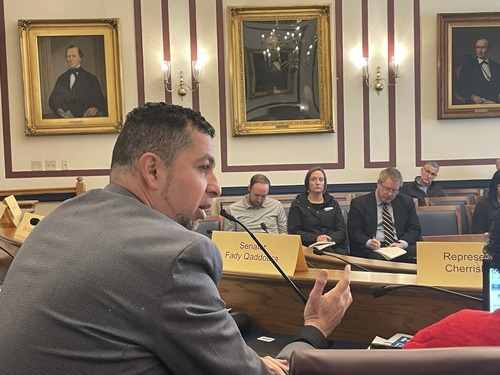Budget, housing testimony seeks more for the poorest Hoosiers

The Senate committee responsible for drafting the state’s budget heard over four hours of public testimony Thursday, as leaders negotiate how to spend more than $43.3 billion over the next two years.
The House version of the budget included an unprecedented increase in education vouchers, which amounts to roughly a third of the overall K-12 budget increase. Democrats argue that most public schools will lose out under the proposal.
In addition to the overall budget, lawmakers fielded testimony from nearly a dozen Hoosiers about a proposal to spur housing developments across the state.
Budget testimony
Several health care providers, including dentists and home health organizations, urged the committee to consider Medicaid reimbursement rates, which they say have lagged behind costs and de-incentivizes providers to participate in the government health insurance programs. Only impoverished Hoosiers qualify for Medicaid.
“Dental providers have not received a comprehensive rate increase in Medicaid reimbursement since 1999,” said Jill Burns, the president of the Indiana Dental Association.
Burns said the Family and Social Services Administration’s primary funding matrix included a $8.9 million investment in dental Medicaid for fiscal years 2024 and another $8.9 million in 2025, something she said was “incredibly inadequate.”
The number, Burns continued, should be closer to $27 million annually.
“If this appropriation request seems high, that is because it has been more than 20 years since there’s been any kind of increase,” she said.
Others, specifically economic development organizations, urged senators to do more for child care — a lack of which hurts their ability to attract workers, they said. Though eligibility and dollar amounts have increased for On My Way Pre-K, the amount of funding hasn’t.
Some also called up the legislature to increase the cigarette tax to $2, up from $0.99 currently, to promote smoking cessation and reduce Indiana’s high smoking rate, which many say contributes to Indiana’s poor health metrics.
The Senate hasn’t yet released their version of the budget, which will be influenced by the above testimony.
“The budget will probably be something that goes down to the wire,” Senate Pro Tem Rodric Bray said Thursday.
Senate Republicans will unveil their version of the budget the week of April 10 to meet a committee deadline. A revenue forecast is expected April 19 and will be used by lawmakers in conference committee to iron out final details.
Housing testimony
A bill creating a revolving loan fund to build infrastructure related to housing developments additionally passed the committee in a 10-1 vote. Proponents say the bill will help solve the state’s housing shortage.
House Bill 1005 will allocate $50 million in the first budget year followed by $25 million the next year that communities can borrow to build sidewalks, sewer systems, roadways and more to incentivize developers to build workforce housing.
The committee opted to amend the bill by removing restrictions on housing or residential tax increment financing programs (HO-TIF), an economic development tool under which property owners pay an additional tax to help fund a specific housing project. In particular, school districts now have far less say in the implementation of HO-TIFs.

Nearly everyone who testified supported the bill. But one entity, the Association of Indiana Counties, had reservations following the change.
Ryan Hoff, the director of government relations and general counsel for the organization, said he’d been neutral on the bill before the amendment and now opposed the measure. He said the state needed to implement more guardrails on HO-TIFs.
“The property tax base is already looked at to provide for a lot of things in the state, including services,” Hoff said. “We’re looking to the property tax to do more and more things.”
Those concerns pushed Sen. Fady Qaddoura, D-Indianapolis, to vote against the bill, saying he didn’t see much evidence of school boards quashing HO-TIFs — as claimed by the amendment’s proponents.
House Speaker Todd Huston, who named the bill as one of his caucus’ priorities, said that he’d supported HO-TIFs in the past and would need to examine the Senate addition.
“We know we need to increase housing availability in the state of Indiana,” Huston, R-Fishers, said. “If this is a tool locals can use — and some locals have used it already – we’ll … have that conversation.”
A push for affordability
But the biggest push for change came from supporters, half of whom asked the committee to add a provision prioritizing affordable housing to increase the state’s supply for the lowest income Hoosiers.
Communities who have completed a housing needs study and loosened their zoning laws to permit smaller lots and accessory dwellings are prioritized for funding. But affordability doesn’t appear on that list.

Testimony from both Habitat for Humanity and the Indianapolis Neighborhood Housing Partnership highlighted development projects that failed or whose final cost out-priced affordable buyers due to the rising costs of infrastructure.
“While we think that (House Bill) 1005 has a lot of potential … it’s currently missing a critical priority that’s needed to develop housing for Hoosiers and communities statewide who’ve experienced gaps in affordable housing,” said Andrew Bradley, the policy director for Prosperity Indiana.
Bradley highlighted results from the organization’s latest release, which demonstrated that for every 100 renters in extreme poverty there were only 39 units available. Currently, the bill does earmark the majority of funding, 70%, for communities with less than 50,000 residents – which can include smaller municipalities within larger cities.
“There’s some data there. However, that gets at the geographies where there is the most need, it doesn’t get to who are the Hoosiers who have the most need,” Bradley said.
The bill advances to the full Senate, where the chamber can consider further amendments.








